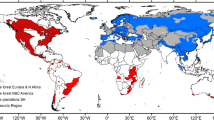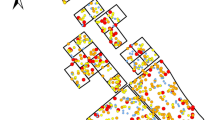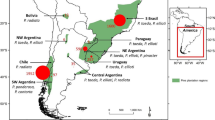Abstract
Frequent bark beetle outbreaks cause biome-scale impacts in boreal and temperate forests worldwide. Despite frequent interceptions at ports of entry, the most aggressive bark beetle species of Ips and Dendroctonus in North America and Eurasia have failed to establish outside their original home continents. Our experiments showed that Ips typographus can breed in six North American spruce species: Engelmann spruce, white spruce¸ Sitka spruce, Lutz spruce, black spruce and red spruce. This suggests that differences between the Eurasian historical host and North American spruce species are not an insurmountable barrier to establishment of this tree-killing species in North America. However, slightly diminished quality of offspring beetles emerged from the North American spruces could reduce the chance of establishment through an Allee effect. The probabilistic nature of invasion dynamics suggests that successful establishments can occur when the import practice allows frequent arrivals of non-indigenous bark beetles (increased propagule load). Model simulations of hypothetical interactions of Dendroctonus rufipennis and I. typographus indicated that inter-species facilitations could result in more frequent and severe outbreaks than those caused by I. typographus alone. The potential effects of such new dynamics on coniferous ecosystems may be dramatic and extensive, including major shifts in forest structure and species composition, increased carbon emissions and stream flow, direct and indirect impacts on wildlife and invertebrate communities, and loss of biodiversity.


Similar content being viewed by others
References
Akkuzu E, Guner S (2008) Defoliation levels of oriental spruce by Ips typographus (L.) in relation to elevation and exposure. J Environ Biol 29:223–226
Allen JL, Wesser S, Markon CJ, Winterberger KC (2006) Stand and landscape level effects of a major outbreak of spruce beetles on forest vegetation in the Copper River Basin, Alaska. For Ecol Manag 227:257–266. doi:10.1016/j.foreco.2006.02.040
Anderbrant O (1990) Gallery construction and oviposition of the bark beetle Ips typographus (Coleoptera: Scolytidae) at different breeding densities. Ecol Entomol 15:1–8
Anderbrant O, Schlyter F, Birgersson G (1985) Intraspecific competition affecting parents and offspring in the bark beetle Ips typographus. Oikos 45:89–98
Annila E (1969) Influence of temperature opon the development and voltinism of Ips typographus L. (Coleoptera, Scolytidae). Ann Zool Fennici 6:161–208
Baier P, Pennerstorfer J, Schopf A (2007) PHENIPS–A comprehensive phenology model of Ips typographus (L.) (Col., Scolytinae) as a tool for hazard rating of bark beetle infestation. For Ecol Manag 249:171–186. doi:10.1016/j.foreco.2007.05.020
Bakke A (1989) The recent Ips typographus outbreak in Norway–experiences from a control program. Hol Ecol 12:515–519
Bakke A, Kvamme T (1993) Beetles attracted to Norway spruce under attack by Ips typographus. Commun Skogforsk 45:1–24
Beckwith RC (1972) Scolytid flight in white spruce stands in Alaska. Can Entomol 104:1977–1983
Bentz BJ, Logan JA, Amman GD (1991) Temperature-dependent development of the mountain pine beetle (Coleoptera: Scolytidae) and simulation of its phenology. Can Entomol 123:1083–1094
Bethlahmy N (1974) More streamflow after a bark beetle epidemic. J Hydrol 23:185–189
Bethlahmy N (1975) A Colorado episode: beetle epidemic, ghost forests, more stream flow. Northwest Sci 49:95–105
Bright DE (1976) The insects and arachnids of Canada, Part 2. Canadian Department of Agricultural Publication, Canada, 1576, p 241
Brockerhoff EG, Bain J, Kimberley M, Knizek M (2006) Interception frequency of exotic bark and ambrosia beetles (Coleoptera : Scolytinae) and relationship with establishment in New Zealand and worldwide. Can J For Res 36:289–298. doi:10.1139/x05-250
Browne FG, Laurie MV (1968) Pests and diseases of forest plantation trees: an annotated list of the principal species occurring in the British Commonwealth. Clarendon Press, Oxford, xi, p 1330
Christiansen E, Bakke A (1988) The spruce bark beetle of Eurasia. In: Berryman AA (ed) Dynamics of forest insect populations. Plenum Press, New York, pp 479–503
Ellstrand NC, Schierenbeck KA (2000) Hybridization as a stimulus for the evolution of invasiveness in plants? Proc Natl Acad Sci U S A 97:7043–7050
Erbilgin N, Raffa KF (2000) Effects of host tree species on attractiveness of tunneling pine engravers, Ips pini, to conspecifics and insect predators. J Chem Ecol 26:823–840
Farjón A (1990) Pinaceae: drawings and descriptions of the genera Abies, Cedrus, Pseudolarix, Keteleeria, Nothotsuga, Tsuga, Cathaya, Pseudotsuga, Larix and Picea. Koeltz, Königstein, p 330
Franceschi VR, Krokene P, Christiansen E, Krekling T (2005) Anatomical and chemical defenses of conifer bark against bark beetles and other pests. New Phytol 167:353–375
Gandhi KJK, Herms DA (2010) Direct and indirect effects of alien insect herbivores on ecological processes and interactions in forests of eastern North America. Biol Invasions 12:389–405. doi:10.1007/s10530-009-9627-9
Global Forest Resources Assessment (2010) Main Report. FAO Forestry paper 163. Food and Agriculture Organization of the United Nations, Rome, Italy, p 340
Grégoire J-C, Evans HF (2004) Damage and control of Bawbilt organisms–an overview. In: Lieutier F, Day KR, Battisti A, Grégoire J-C, Evans HF (eds) Bark and wood boring insects in living trees in Europe, a synthesis. Kluwer Academic Publishers, Dordrecht, pp 19–37
Haack RA (2001) Intercepted Scolytidae (Coleoptera) at U.S. ports of entry: 1985–2000. Integr Pest Manag Rev 6:253–282
Haack RA (2006) Exotic bark- and wood- boring Coleoptera in the United States: recent establishments and interceptions. Can J For Res 36:269–288
Haack RA, Petrice TR (2009) Bark- and wood-borer colonization of logs and lumber after heat treatment to ispm 15 specifications: the role of residual bark. J Econ Entomol 102:1075–1084
Haack RA, Herard F, Sun JH, Turgeon JJ (2010) Managing invasive populations of Asian Longhorned Beetle and Citrus Longhorned Beetle: a worldwide perspective. Ann Rev Entomol 55:521–546. doi:10.1146/annurev-ento-112408-085427
Hansson L (1994) Vertebrate distributions relative to clear-cut edges in a boreal forest landscape. Landsc Ecol 9:105–115
Hoffard WH (1985) Southern pine beetle - a would-be manager of southern forests. In: Loomis RC, Tucker S, Hofacker TH (eds) Insect and disease conditions in the United States. USDA For Serv Gen Tech Rep WO-46, pp 32–37
Holsten EH, Werner RA (1997) Engraver beetles in Alaska forests. USDA For Serv. Leaflet, Missoula, p 6
Holsten EH, Werner RA, Develice RL (1995) Effects of a spruce beetle (Coleoptera: Scolytidae) outbreak and fire on Lutz spruce in Alaska. Environ Entomol 24:1539–1547
Holsten EH, Thier RW, Munson AS, Gibson KE (2000) The Spruce beetle. forest insect & disease leaflet 127. U. S. Department of Agriculture Forest Service, USA
Kean JM, Barlow ND (2000) Can host-parasitoid metapopulations explain successful biological control? Ecology 81:2188–2197
Kenis M, Auger-Rozenberg MA, Roques A, Timms L, Pere C, Cock M, Settele J, Augustin S, Lopez-Vaamonde C (2009) Ecological effects of invasive alien insects. Biol Invasions 11:21–45. doi:10.1007/s10530-008-9318-y
Kolbe JJ, Glor RE, Schettino LRG, Lara AC, Larson A, Losos JB (2004) Genetic variation increases during biological invasion by a Cuban lizard. Nature 431:177–181. doi:10.1038/nature02807
Kovacs KF, Haight RG, McCullough DG, Mercader RJ, Siegert NW, Liebhold AM (2010) Cost of potential emerald ash borer damage in US communities, 2009–2019. Ecol Econ 69:569–578. doi:10.1016/j.ecolecon.2009.09.004
Kurz WA, Dymond CC, Stinson G, Rampley GJ, Neilson ET, Carroll AL, Ebata T, Safranyik L (2008) Mountain pine beetle and forest carbon feedback to climate change. Nature 452:987–990
Lance EW, Howell S (2000) Survey of songbirds during a spruce beetle (Dendroctonus rufipennis) outbreak on the Kenai Peninsula, Alaska. Northwest Nat 81:1–10
Lance EW, Howell SM, Lance BK, Howlin S, Suring LH, Goldstein MI (2006) Spruce beetles and timber harvest in Alaska: implications for northern red-backed voles. For Ecol Manag 222:476–479. doi:10.1016/j.foreco.2005.11.023
Lange H, Økland B, Krokene P (2006) Thresholds in the life cycle of the spruce bark beetle under climate change. Interjournal for Complex Syst 1648:1–10
Lee CE (2002) Evolutionary genetics of invasive species. Trends Ecol Evol 17:386–391
Li JS, Chang GB, Song YS, Wang YW, Chang BS (2001) Control project on red turpentine beetle (Dendroctonus valens). For Pest Dis 4:41–44
Liebhold AM, Tobin PC (2008) Population ecology of insect invasions and their management. Ann Rev Entomol 53:387–408. doi:10.1146/annurev.ento.52.110405.091401
Lindhe A, Lindelöw A (2004) Cut high stumps of spruce, birch, aspen and oak as breeding substrates for saproxylic beetles. For Ecol Manag 203:1–20. doi:10.1016/j.foreco.2004.07.047
Lindhe A, Lindelöw A, Asenblad N (2005) Saproxylic beetles in standing dead wood density in relation to substrate sun-exposure and diameter. Biodivers Conserv 14:3033–3053. doi:10.1007/s10531-004-0314-y
Logan JA, Powell JA (2001) Ghost forests, global warming, and the mountain pine beetle. Am Entomol 47:160–173
Martikainen P, Siitonen J, Kaila L, Punttila P, Rauh J (1999) Bark beetles (Coleoptera, Scolytidae) and associated beetle species in mature managed and old-growth boreal forests in southern Finland. For Ecol Manag 116:233–245
McFarlane W, Logan JA, Wilcox L, Kern WR, Gordon BS (2009) Using an innovative aerial survey method, to monitor mountain pine beetle outbreaks in whitebark pine of greater Yellowstone ecosystem. IUFRO-meeting (Units 7.03.05/7.03.07). Forest Insects and Environmental Change, Jackson Hole
McGregor MD (1985) Mountain pine beetle–the conflict between people and the beetle. In: Loomis RC, Tucker S and Hofacker TH (eds) Insect and disease conditions in the United States. USDA For Serv Gen Tech Rep WO-4616-23
McMahon SM, Diez JM (2007) Scales of association: hierarchical linear models and the measurement of ecological systems. Ecol Lett 10:437–452. doi:10.1111/j.1461-0248.2007.01036.x
Morehouse K, Johns T, Kaye J, Kaye A (2008) Carbon and nitrogen cycling immediately following bark beetle outbreaks in southwestern ponderosa pine forests. For Ecol Manag 255:2698–2708. doi:10.1016/j.foreco.2008.01.050
Økland B (1996) Unlogged forests: important sites for preserving the diversity of mycetophilids (Diptera: Sciaroidea). Biol Conserv 76:297–310
Økland B (2002) Canopy cover favours sporocarp-visiting beetles in spruce forests. Nor J Entomol 49:29–39
Økland B, Bjørnstad ON (2003) Synchrony and geographical variation of the spruce bark beetle (Ips typographus) during a non-epidemic period. Popul Ecol 45:213–219
Økland B, Bjørnstad ON (2006) A resource depletion model of forest insect outbreaks. Ecology 87:283–290
Økland B, Bakke A, Hågvar S, Kvamme T (1996) What factors influence the diversity of saproxylic beetles? A multiscaled study from a spruce forest in southern Norway. Biodivers Conserv 5:75–100
Økland B, Skarpaas O, Kausrud K (2009) Threshold facilitations of interacting species. Popul Ecol 51:513–523. doi:10.1007/s10144-009-0141-9
Økland B, Skarpaas O, Schroeder M, Magnusson C, Lindelöw Å, Thunes K (2010) Is eradication of the pinewood nematode (Bursaphelenchus xylophilus) likely? An evaluation of current contingency plans. Risk Anal 30:1424–1439. doi: 10.1111/j.1539-6924.2010.01431.x
Peters DPC, Pielke RA, Bestelmeyer BT, Allen CD, Munson-McGee S, Havstad KM (2004) Cross-scale interactions, nonlinearities, and forecasting catastrophic events. Proc Natl Acad Sci U S A 101:15130–15135. doi:10.1073/pnas.0403822101
Piel F, Gilbert M, De Canniere C, Gregoire JC (2008) Coniferous round wood imports from Russia and Baltic countries to Belgium. A pathway analysis for assessing risks of exotic pest insect introductions. Divers Distributions 14:318–328. doi:10.1111/j.1472-4642.2007.00390.x
Pimentel D (2002) Biological Invasions: economic and environmental cost of alien plant, animal and microbe species. CRC Press, Boca Raton
Potts DF (1984) Hydrologic impacts of a large scale mountain pine beetle (Dendroctonus ponderosae Hopkins) epidemic. Water Res Bull Paper 83122:373–377
R Development Core Team (2009) R: a language and environment for statistical computing. The R foundation for statistical computing, Vienna, Austria www.r-project.org
Raffa K, Aukema B, Erbilgin N, Klepzig K, Wallin K (2005) Interactions among conifer terpenoids and bark beetles across multiple levels of scale: an attempt to understand links between population patterns and physiological processes. Rec Adv Phytochem 39:79–118
Raffa KF, Aukema BH, Bentz BJ, Carroll AL, Hicke JA, Turner MG, Romme WH (2008) Cross-scale drivers of natural disturbances prone to anthropogenic amplification: the dynamics of bark beetle eruptions. Bioscience 58:501–517. doi:10.1641/b580607
Ran JH, Wei XX, Wang XQ (2006) Molecular phylogeny and biogeography of Picea (Pinaceae): Implications for phylogeographical studies using cytoplasmic haplotypes. Mol Phylogenet Evol 41:405–419. doi:10.1016/j.ympev.2006.05.039
Shigesada N, Kawasaki K (1997) Biological invasions: theory and practice. Oxford University Press, Oxford, p 205
Siitonen J (2001) Forest management, coarse woody debris and saproxylic organisms: fennoscandian boreal forests as an example. Ecol Bull 49:11–41
Simberloff D (2005) The politics of assessing risk for biological invasions: the USA as a case study. Trend Ecol Evol 20:216–222. doi:10.1016/j.tree.2005.02.008
Simberloff D (2009) We can eliminate invasions or live with them. Successful management projects. Biol Invasions 11:149–157
Skarpaas O, Økland B (2009) Timber import and the risk of forest pest introductions. J Appl Ecol 46:55–63. doi:10.1111/j.1365-2664.2008.01561.x
Stenseth NC (1977) Food selection of the field vole Microtus agrestis. Oikos 29:511–524
Stephen FM, Grégoire JC (2001) Introduction and establishment of exotic bark beetles. Risks of exotic forest pests and their impact on trade. International Online Workshop April 16–29. http://www.apsnet.org/online/proceedings/exoticpest/Papers/stephen.htm
Suarez AV, Tsutsui ND (2008) The evolutionary consequences of biological invasions. Mol Ecol 17:351–360
Taylor CM, Hastings A (2005) Allee effects in biological invasions. Ecol Lett 8:895–908. doi:10.1111/j.1461-0248.2005.00787.x
Tollefsrud MM, Sonstebo JH, Brochmann C, Johnsen O, Skroppa T, Vendramin GG (2009) Combined analysis of nuclear and mitochondrial markers provide new insight into the genetic structure of North European Picea abies. Heredity 102:549–562. doi:10.1038/hdy.2009.16
Turchin P (2003) Complex population dynamics: a theoretical/empirical synthesis. Princeton University Press, New Jersey, p 451
Uunila L, Guy B, Pike R (2006) Hydrologic effects of mountain pine beetle in the interior pine forests of British Columbia: key questions and current knowledge. Watershed Manag Bull 9:2–6
Veblen TT, Hadley KS, Reid MS, Rebertus AJ (1991) The response of sub-alpine forests to spruce beetle outbreak in Colorado. Ecology 72:213–231
Wallin KF, Raffa KF (2004) Feedback between individual host selection behavior and population dynamics in an eruptive herbivore. Ecol Monogr 74:101–116
Wermelinger B (2004) Ecology and management of the spruce bark beetle Ips typographus—a review of recent research. For Ecol Manag 202:67–82
Werner RA, Holsten EH, Matsuoka SM, Burnside RE (2006) Spruce beetles and forest ecosystems in south-central Alaska: A review of 30 years of research. For Ecol Manag 227:195–206. doi:10.1016/j.foreco.2006.02.050
Weslien J, Annila E, Bakke A, Bejer B, Eidmann HH, Narvestad K, Nikula A, Ravn HP (1989) Estimating risks for spruce bark beetle (Ips typographus (L.)) damage using pheromone-baited traps and trees. Scand J For Res 4:87–98
Williamson MH (1996) Biological Invasions. Chapman & Hall, London
Wood DL (1972) Selection and colonization of ponderosa pine by bark beetles. In: van Emden HF (ed) Insect/plant relationships. Blackwell Scientific, London, pp 101–117
Wood DL (1982a) The role of pheromones, kairomones, and allomones in the host selection and colonization behaviour of bark beetles. Ann Rev Entomol 27:411–446
Wood SL (1982b) The bark and Ambrosia beetles of North and Central America (Coleoptera: Scolytidae), a taxonomic monograph. Great Basin Nat mem 6:1–1359
Wood SL, Bright DE (1992) A catalog of Scolytidae and Platypodidae (Coleoptera), part 2: taxonomic index. Great Basin Nat Mem 13:1–1553
Wood CS, Van Sickle GA (1992) Forest insect, disease conditions British Colombia, Yukon–1992. Information Report BC-X-340. Forestry Canada Pacific Forestry Centre, Victoria
Yamaoka Y, Wingfield MJ, Takahashi I, Solheim H (1997) Ophiostomatoid fungi associated with the spruce bark beetle Ips typographus f. japonicus in Japan. Mycol Res 101:1215–1227
Yan Z, Sun J, Don O, Zhang Z (2005) The red turpentine beetle, Dendroctonus valens LeConte (Scolytidae): an exotic invasive pest of pine in China. Biodivers Conserv 14:1735–1760
Acknowledgments
Gro Wollebæk, Ulf Johansson, Morgan Erixon and Anna Björklund are thanked for technical assistance in the field experiment. Thanks to Mari Mette Tollefsen and Eva Solbjørg Flo Heggem for their contributions in developing distribution map of spruce species, to Ken Raffa for useful references about ecosystem function effects, to Stein Tomter for compiling statistics about forest cover and to Wendy Fjeldstad for text comments.
Author information
Authors and Affiliations
Corresponding author
Rights and permissions
About this article
Cite this article
Økland, B., Erbilgin, N., Skarpaas, O. et al. Inter-species interactions and ecosystem effects of non-indigenous invasive and native tree-killing bark beetles. Biol Invasions 13, 1151–1164 (2011). https://doi.org/10.1007/s10530-011-9957-2
Received:
Accepted:
Published:
Issue Date:
DOI: https://doi.org/10.1007/s10530-011-9957-2




